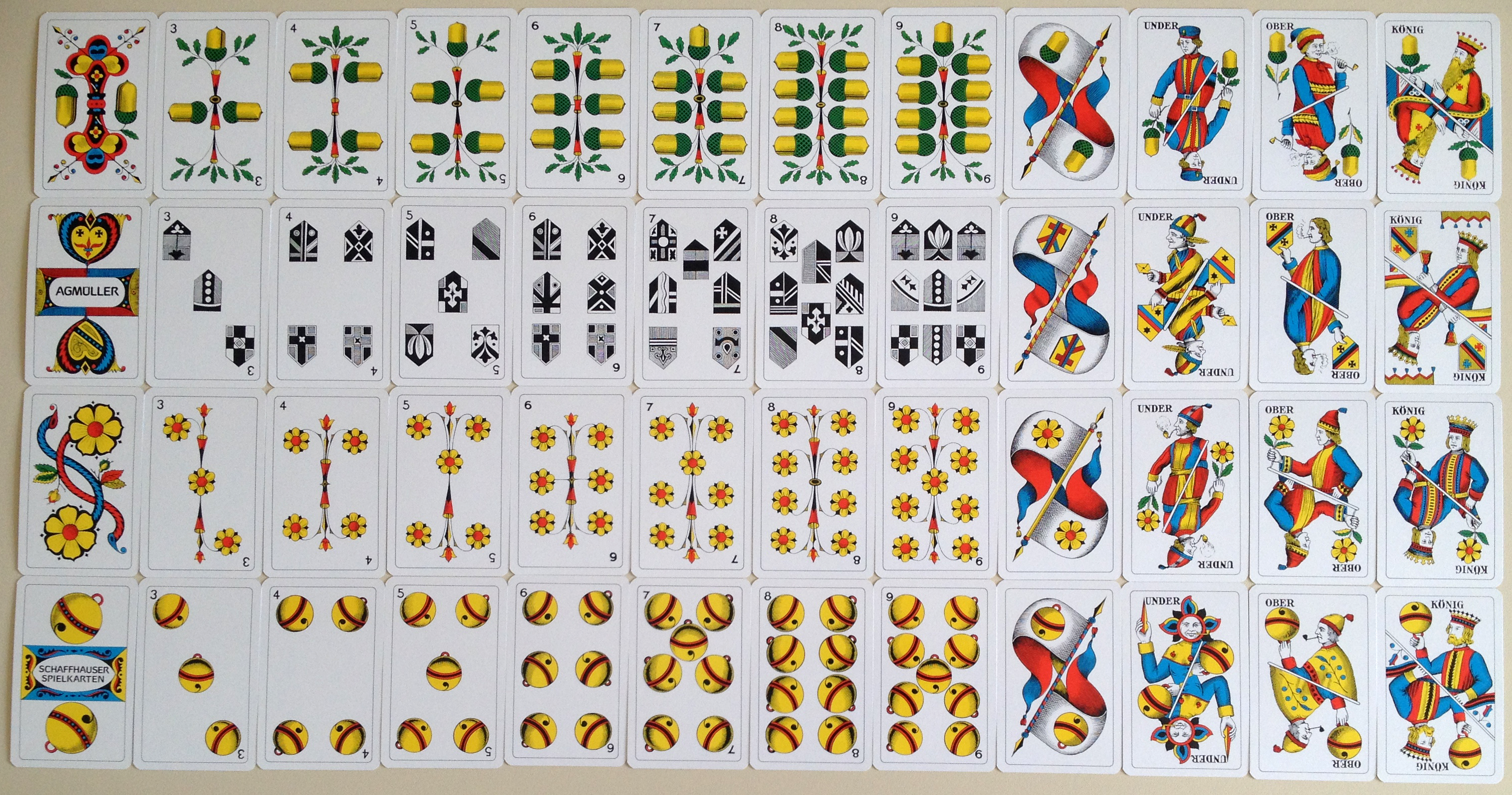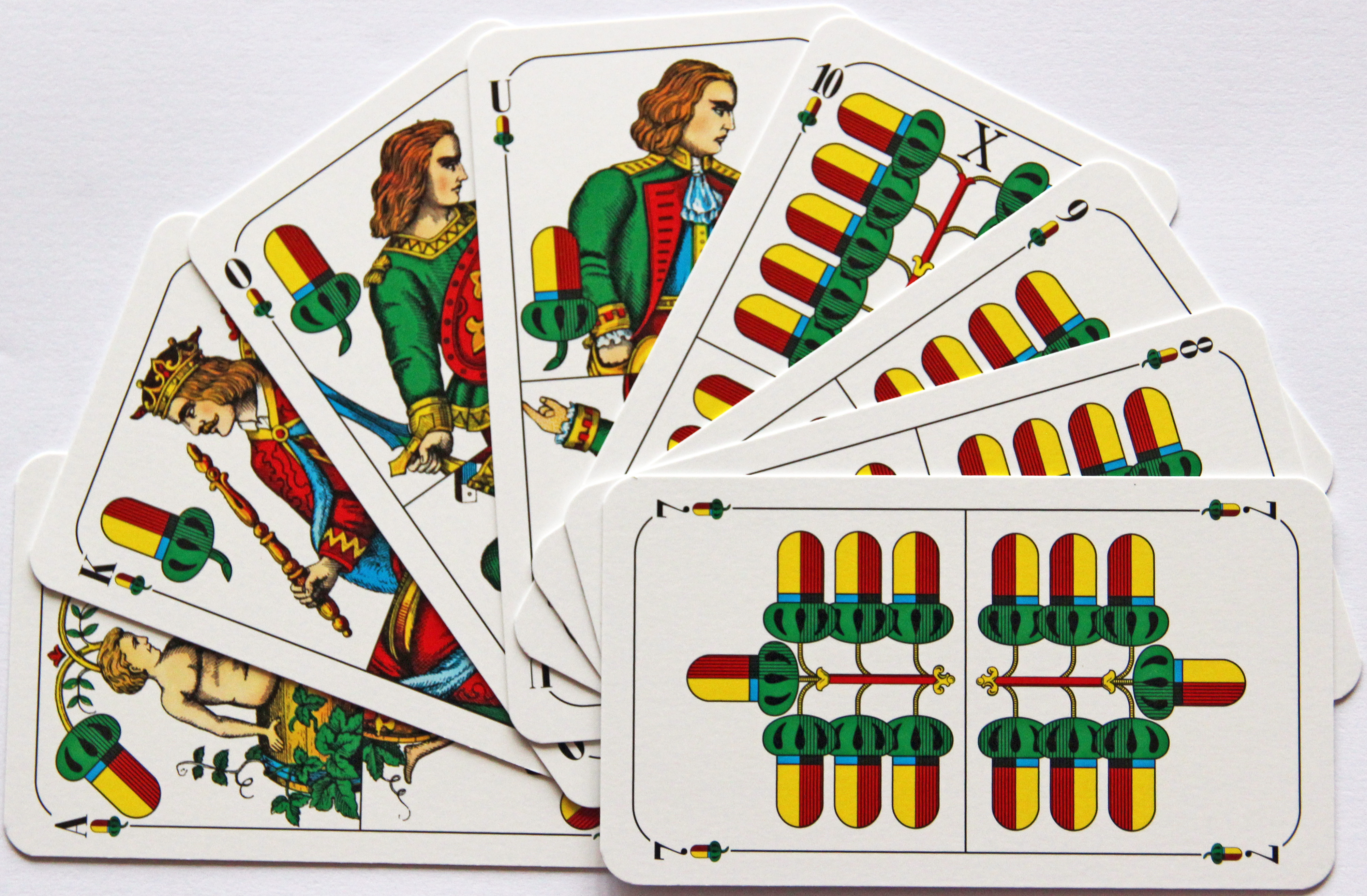|
Knüffeln
Knüffeln is a very old trick-taking card game for four players, playing in pairs, that is still played in North Germany. Once considered the national game of Frisia, Knüffeln is a descendant of Karnöffel, the oldest identifiable European card game in the history of playing cards with a continuous tradition of play down to the present day. Knüffeln, itself several centuries old, became popular in Frisia in North Germany and, despite being described in 1924 as in danger of extinction, is still taught and played in North Frisia. Like its parent, it uses a 48-card pack, has a highly unusual hierarchy and cards with special properties, including the "surprising feature" of two chosen suits whose cards have a range of trump-like powers or no powers at all.Dummett (1980), pp. 185–187. Another oddity is that partners are allowed to openly communicate with one another and try to bluff the opposition about their hands and each side has a 'director' who may instruct the partner on ... [...More Info...] [...Related Items...] OR: [Wikipedia] [Google] [Baidu] |
Karnöffel
Karnöffel is a trick-taking card game which probably came from the upper-German language area in Europe in the first quarter of the 15th century. It first appeared listed in a municipal ordinance of Nördlingen, Bavaria, in 1426 among the games that could be lawfully played at the annual city fête. This makes the game the oldest identifiable European card game in the history of playing cards with a continuous tradition of play down to the present day. History The earliest substantial reference to Karnöffel is a poem by Meissner, written in or before 1450. Historically ''karnöffeln'' meant "to cudgel, thrash or flog", but in medieval times, a ''Karnöffel'' was also the word for an inguinal hernia. Karnöffel had a suit, the 'chosen suit', in which some cards had a higher priority than cards in other suits, which indicates that it might be a possible precursor to the trump suit of Tarot. The earliest forms of Karnöffel utilized a deck of 48 cards, Aces having been removed ... [...More Info...] [...Related Items...] OR: [Wikipedia] [Google] [Baidu] |
German Solo
German Solo or just Solo is a German 8-card plain-trick game for 4 individual players using a 32-card, German- or French-suited Skat pack. It is essentially a simplification of Quadrille, itself a 4-player adaptation of Ombre.''Neuestes Spielbuch'' (1834), pp. 116–128. As in Quadrille, players bid for the privilege of declaring trumps and deciding whether to play alone or with a partner. Along with Ombre, Tarock and Schafkopf, German Solo influenced the development of Skat.Hoffmann & Dietrich (1982). Parlett calls it a "neat little descendant of Quadrille" and "a pleasant introduction" to the Ombre family of games. Name The game is often called German Solo in English and German sources to distinguish it from other national games such as American Solo, Spanish Solo and English Solo. However, it was often known locally just as Solo or, in the Münsterland, as Sollo. Historically it was also referred to as German Ombre and some American publications actually call the game Om ... [...More Info...] [...Related Items...] OR: [Wikipedia] [Google] [Baidu] |
Matador (cards)
The following is a glossary of terms used in card games. Besides the terms listed here, there are thousands of common and uncommon slang terms. Terms in this glossary should not be game-specific (e.g. specific to Bridge, Hearts, Poker or Rummy), but apply to a wide range of card games. For glossaries that relate primarily to one game or family of similar games, see Game-specific glossaries. A ; Ace # The card with one pip in a pack of cards. Usually the highest card of a suit, ranking immediately above the King. May also occupy the lowest rank. # Commonly refers to the Deuce or Two in German-suited packs which don't have real Aces. Often the highest card of a suit. ; Acorns : One of the four suits in a German-suited pack of cards. Symbol: ; active # A card that is in play i.e. not sleeping. # See active player. ; active player # A player who receives cards in the current deal (i.e. is not sitting out because there are more players than the game is designed for a ... [...More Info...] [...Related Items...] OR: [Wikipedia] [Google] [Baidu] |
Kaiserspiel
Kaiserspiel, also called Kaisern or Cheisärä, is a card game, usually for 4 or 6 players, that is played in parts of Switzerland using a variant of the standard Swiss playing cards with 40 or 48 cards. It is a descendant of Karnöffel, one of the oldest card games known.''Kaiserspiel'' at www.pagat.com. Retrieved 4 Jun 2018. It is sometimes misleadingly called ''Kaiserjass'', although it has nothing to do with the family of games that are popular in Switzerland. Cards The Kaiserspiel pack comprises four suits: , |
Chosen Suit
The following is a glossary of terms used in card games. Besides the terms listed here, there are thousands of common and uncommon slang terms. Terms in this glossary should not be game-specific (e.g. specific to Bridge, Hearts, Poker or Rummy), but apply to a wide range of card games. For glossaries that relate primarily to one game or family of similar games, see Game-specific glossaries. A ; Ace # The card with one pip in a pack of cards. Usually the highest card of a suit, ranking immediately above the King. May also occupy the lowest rank. # Commonly refers to the Deuce or Two in German-suited packs which don't have real Aces. Often the highest card of a suit. ; Acorns : One of the four suits in a German-suited pack of cards. Symbol: ; active # A card that is in play i.e. not sleeping. # See active player. ; active player # A player who receives cards in the current deal (i.e. is not sitting out because there are more players than the game is designed f ... [...More Info...] [...Related Items...] OR: [Wikipedia] [Google] [Baidu] |
North Frisia
North Frisia (; ; ) is the northernmost portion of Frisia, located in Schleswig-Holstein, Germany between the rivers Eider and Wiedau. It also includes the North Frisian Islands and Heligoland. The region is traditionally inhabited by the North Frisians. History Ancient settlements The geestland islands along the North Frisian coastline were already densely settled in the time of the early Roman Empire while the marshes further inland were not suited for settling. Only a few ancient marshland settlements have been found during archaeological excavations, namely in the modern area of southern Sylt, the Wiedingharde and along the southern Eiderstedt peninsula. With the beginning of the Migration Period, the number of settlements in North Frisia became ever lesser and many were totally abandoned. A new increase in population in the 8th century has been attributed to immigration but it is thought that the area had not been completely depopulated before.Kühn, Hans Joachim, "Archäo ... [...More Info...] [...Related Items...] OR: [Wikipedia] [Google] [Baidu] |
Norstedt
Norstedt ( da, Nordsted, North Frisian: ''Noorst'') is a municipality in the district of Nordfriesland, in Schleswig-Holstein, Germany Germany,, officially the Federal Republic of Germany, is a country in Central Europe. It is the second most populous country in Europe after Russia, and the most populous member state of the European Union. Germany is situated betwe .... External links * References Municipalities in Schleswig-Holstein Nordfriesland {{Nordfriesland-geo-stub ... [...More Info...] [...Related Items...] OR: [Wikipedia] [Google] [Baidu] |
Geest
Geest is a type of landform, slightly raised above the surrounding countryside, that occurs on the plains of Northern Germany, the Northern Netherlands and Denmark. It is a landscape of sandy and gravelly soils formed as a glacial outwash plain and now usually mantled by a heathland vegetation on the glacial deposits left behind after the last ice age during the Pleistocene epoch.Whittow, John (1984). ''Dictionary of Physical Geography''. London: Penguin, p. 214. . The term ''geest'' is a substantivisation of the Low German adjective ''güst'', which means "dry and infertile". It is an Old Drift landscape, characterised by the sandy depositions of the Ice Age. In the depressions between the raised flats are wet meadows and, where drainage is poor, bogs. Geest lands are made up of moraines and sandurs. They are almost always next to flat marshlands, the geest being higher and better protected against flood but, compared to the marsh, with poor soil for agriculture. Where the ... [...More Info...] [...Related Items...] OR: [Wikipedia] [Google] [Baidu] |
Viöl
Viöl (; da, Fjolde, North Frisian language, North Frisian: ''Fjåål'') is a municipality in the district of Nordfriesland, in Schleswig-Holstein, Germany. It is situated approximately 12 km northeast of Husum, Germany, Husum, and 30 km southwest of Flensburg. Viöl is the seat of the ''Amt (subnational entity), Amt'' of (collective municipality) Viöl (Amt), Viöl. A variety of South Jutlandic was spoken there until 1937, called "Fjoldedansk". References Nordfriesland {{Nordfriesland-geo-stub ... [...More Info...] [...Related Items...] OR: [Wikipedia] [Google] [Baidu] |
Bohmstedt
Bohmstedt ( da, Bomsted, North Frisian: ''Bååmst'') is a municipality in the district of Nordfriesland, in Schleswig-Holstein, Germany Germany,, officially the Federal Republic of Germany, is a country in Central Europe. It is the second most populous country in Europe after Russia, and the most populous member state of the European Union. Germany is situated betwe .... References Nordfriesland {{Nordfriesland-geo-stub ... [...More Info...] [...Related Items...] OR: [Wikipedia] [Google] [Baidu] |
Trick-taking
A trick-taking game is a card or tile-based game in which play of a ''hand'' centers on a series of finite rounds or units of play, called ''tricks'', which are each evaluated to determine a winner or ''taker'' of that trick. The object of such games then may be closely tied to the number of tricks taken, as in plain-trick games such as contract bridge, whist, and spades, or to the value of the cards contained in taken tricks, as in point-trick games such as pinochle, the tarot family, briscola, and most evasion games like hearts. Trick-and-draw games are trick-taking games in which the players can fill up their hands after each trick. In most variants, players are free to play any card into a trick in the first phase of the game, but must ''follow suit'' as soon as the stock is depleted. Trick-avoidance games like reversis or polignac are those in which the aim is to avoid taking some or all tricks. The domino game Texas 42 is an example of a trick-taking game that is not a ca ... [...More Info...] [...Related Items...] OR: [Wikipedia] [Google] [Baidu] |
Klockries
Risum-Lindholm ( frr, Risem-Loonham) is a municipality in the district of Nordfriesland, in Schleswig-Holstein, Germany. Geography Location Risum-Lindholm lies about five kilometres southeast of Niebüll and six kilometres west of Leck on a boundary between a low, sandy area of geest and the marshes. Villages The municipality was formed in 1969 from the formerly independent municipalities of Risum and Lindholm. Because it extends over several kilometres, the villages of Maasbüll (North Frisian: ''Moosbel'', Danish: ''Masbøl''), Risum (NF: ''Risem''), Lindholm (NF: ''Lunham''), Klockries (NF: ''Klookriis'', Dan: ''Klokris''), Wegacker (NF: ''Wäieeker'') and Kremperhaus (Dan. ''Krempehus'') (beside Broweg (NF: ''Bruwäi''), Läiged, Legerade (NF: ''Läigeroos'') and Herrenkoog (NF: ''Hiirnekuch'', Dan: ''Herrekog''Videnskabernes Selskab: ''Kaart over den sydlige del af Slesvig'', Kopenhagen 1864), which do not lie on the long village street) are of great importance for d ... [...More Info...] [...Related Items...] OR: [Wikipedia] [Google] [Baidu] |






